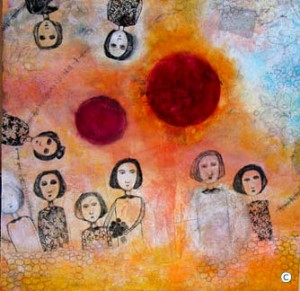A story. A story under a story. And a story under that, and behind that one, and—wait!—there is another, larger one.
When my first child was born, the doctor threatened forceps, and so I pushed. But once out of my body, my son seemed never to want to be close again; for a decade as a young man he may as well have been orbiting a space station. My second child, born eight years later, was lifted from the gash in my belly in a dark room while I waited for a nurse, the doctor—anyone—to explain the abrupt silence. All I heard was the clink of instruments, low whispers. The doctor who should have known better moved to Ontario shortly afterward.
You see what I mean. Stories peek out from under stories, bubbling with energy and steeped in significance. Being a mother—whether we birth a child, adopt one, take in our cousin’s orphaned daughter, or simply open the door to the stray in the neighbourhood who prefers our house because he feels safer—makes each of us a constellation of stories. Stories leak out of our pores; they hovered like mist around the body of our own mother. We create them with family, we inherit them, we draw on them for inspiration, and we shrink from them when they haunt or frighten us. That scar on our face is a story untold. A photograph, a ring, or the child-sized jean jacket we won’t throw away? A story. Every woman I know mothers a person or a creature or a cause or a place. And everyone I know is a universe of untold stories.
We tell ourselves stories in order to live, says the writer Joan Didion. The truth about stories is that’s all we are, says Thomas King. And he adds: Don’t say in the years to come that you would have lived your life differently if only you had heard this story. You’ve heard it now.
And that, for me, is the power stories hold. They inspire change. Once I have heard the details of the rape of a friend’s daughter (as statistics show, every 17 minutes across Canada a woman is raped), I cannot un-know that story. After December 1989, when 14 young women were murdered in Montreal at École Polytechnique, violence against women became a public story none of us can now refuse to know. These stories invite me to focus my lens on the epidemic of gendered violence in the world. Each woman’s story is singular, but it’s universal, too. I am taken to Saskatoon or to Highway 16 (The Highway of Tears) between Prince George and Prince Rupert. As a women with aboriginal roots, I am galvanized by the profound losses in these communities: I am implicated. As a woman, as a mother, I am connected. But the connections reach beyond Canada: I look across the globe, to India, to the Sudan.
Sometimes it all seems overwhelming. What can any of us do in the face of such enormous pain and horror in the world?
What’s important to me is to remember the sanctity of each woman’s life, and the need for each of us to claim our own story and to write it or tell it, if we can. Writing and speaking what we know force us to pay attention, to honour experience. When I’m walking on the beach I look at the stunning detail the tide scrapes in the sand; I watch the movement of clouds, or the occasional ship on the horizon. When I listen to a young woman’s story, I try to hear beyond her words. I cultivate awareness, and when I work with women as they write their lives, I try to help them become aware of their singular vision and their strength. Each individual carries a world.
It’s also important to me to create a space to talk with young people, especially young men, about their beliefs about girls and sex; I can call them on their jokes, push them on their offhand remarks (especially those two sons, whom I mentioned earlier, and who are now good men). I can bring to my classroom glossy ads I find in the local newspaper, ads such as the one showing a girl wearing little else but hockey gear, bearing the caption, “pull the goalie and score!” My students (male and female) will discuss this ad, search for more ads in print and electronic media that consider women as available sex objects. (I can—and I did—phone the company that distributed the ad and sent a note to Advertising Standards Canada). Equally important, though, I can continue to create a safe environment for awkward and sometimes tough conversations, for young men and women to make connections among, between, under and beyond the stories around them.
A story under a story can move each of us. Mother Teresa said it best: I alone cannot change the world, but I can cast a stone across the waters to create many ripples.


